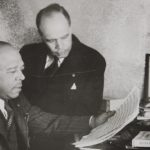November 1, 2025
“Fragrant Memories”
The Church of St. John the Divine
Houston, Texas – USA
ROCO; Mei-Ann Chen, conductor; Laura Frautschi, guest concertmaster/violin soloist.
Johann Sebastian BACH: Toccata and Fugue in D minor, BMV 565 (world premiere arrangement by Anthony DiLorenzo)
David T. LITTLE: Haunted Topography (2013)
Ludwig van BEETHOVEN/Const. by Barry COOPER: Symphony No. 10 in E-flat Major
George CHASE: Fanfare: Please Get Bach In Time
John WINEGLASS: Sacred Ground
Juan Pablo CONTRERAS: La Minerva (2023), Mvt. 3
Maurice RAVEL: La Valse (world premiere arrangement by Anthony DiLorenzo)
Lawrence Wheeler | 3 NOV 2025
Houston’s 40-piece chamber orchestra, ROCO, continued its Season 21 with three world premieres, two contemporary works, and a Beethoven symphony constructed from sketches. Titled Fragrant Melodies, the concert was led by conductor Mei-Ann Chen at The Church of St. John the Divine. Serving as guest concertmaster and soloist was Laura Frautschi. True to form, ROCO once again proved itself a premier ensemble in more ways than one.
The program opened with a ROCO-commissioned world premiere rescoring by Anthony DiLorenzo of the Toccata and Fugue in D Minor by Johann Sebastian Bach. One of Bach’s best-known organ works, its actual origin is the subject of some debate. It survives from a manuscript produced by Johannes Ringk, a student of Johann Peter Kellner, and a friend—and possible pupil—of Bach. Some theorize that the Toccata and Fugue was originally a Ringk tune.
The work has been orchestrated numerous times, all attempting to capture the organ’s monumental sonority. Anthony DiLorenzo’s version, the first for chamber orchestra, takes a different path. By adding instruments not typically found in a chamber ensemble—celesta, vibraphone, glockenspiel, and tuba—he emphasizes transparency and tone color over sheer volume. In the resonant acoustics of the church, there was ample power when needed, but the result was closer in spirit to Respighi’s Ancient Airs and Dances than Pines of Rome. The orchestration was masterful: complete, colorful, and fully convincing.
Chen’s conducting of the Bach was among her finest work of the evening. Her clear indication of multiple tempo changes yielded precise ensemble playing from the ROCO musicians. The reduced size from a typical orchestra meant less weight in the sound, allowing for her interpretation, which was more straightforward—with less wait.
David T. Little’s Haunted Topography (2013) is a meditation on a story told to the composer in 2011: a mother’s decades-long grief over a son killed in Vietnam, and her need to know where he died in order to heal. The music unfolds slowly. Piano and vibraphone first suggest a measured, clocklike pulse; a bass line enters, and the texture remains rhythmically static. A long viola solo circles around two repeated notes. To this listener, the piece never fully transcended its meditative state. Given the heartbreaking subject, one longed for a more tangible emotional trajectory.
Beethoven’s Symphony No. 10 in E-flat Major is a hypothetical work, assembled in 1988 by musicologist Barry Cooper from fragmentary sketches for its first movement. It most resembles Beethoven’s earlier symphonies—particularly Nos. 3 and 6—yet feels less than fully realized. Hints of Schubert appear, but there is little of the harmonic or rhythmic tension that defines Beethoven’s voice. It remains a curiosity, and one hearing feels sufficient. Adding to the sense of incompleteness, Chen miscued the first violins on a fortissimo entrance—a slip that took a few bars to recover.
After intermission, seven musicians performed a brief fanfare, Please Get Bach on Time, by ROCO trumpeter George Chase. Ironically, the audience didn’t.
Composer John Wineglass, best known for his film and television scores, has in recent years turned his attention to concert works infused with social awareness. ROCO presented the world premiere of Sacred Ground, inspired in part by Freedmen’s Town, Houston’s historically African American neighborhood founded by formerly enslaved people. The phrase “sacred ground” evokes a sanctuary where marginalized communities can find solace, identity, and strength. Projected images of Freedmen’s Town landmarks, including Antioch Missionary Baptist Church, accompanied the music.
The first movement, “Unemancipated,” portrays the grim realities of “freed” men and women still trapped under Jim Crow’s shadow. Following a somber D-minor chord, a plaintive viola melody emerges; the music intensifies with anguished outbursts before subsiding into quiet resignation. Without pause, the second movement, “Lamentations of the Sacred,” unfolds as a ghostly danse macabre that evolves into a fully orchestrated march. Its counterpoint is striking, with fleeting echoes of Schindler’s List.
Sacred Ground proved powerful, moving, and memorable. Chen and the ROCO musicians delivered it with conviction. It is admirable—and important—that Houston’s African American history found such eloquent expression in River Oaks, worlds away from Freedmen’s Town itself.
Juan Pablo Contreras’ “Himno a la Mujer” (Hymn to Women”)—the third movement from his violin concerto La Minerva—was nominated for a 2024 Latin Grammy Award for Best Classical Contemporary Composition. The moderately paced huapango alternates between 6/8 and 4/8 time, with mixed percussion and strings plucked like a guitar or jarana. It’s irresistibly rhythmic, provided one can follow the shifting meters. Frautschi’s solo playing was poised and elegant, capped by a deft cadenza featuring left-hand pizzicato.
The program concluded with a world-premiere arrangement of Ravel’s La Valse for chamber orchestra, also by DiLorenzo. Another orchestral triumph, it sacrificed none of the work’s sweep or color—indeed, a string nonet version already exists. Here, every texture felt intact yet refreshingly lean. The performance moved confidently from the misty opening to the stormy finish, though the closing shift to duple meter was not clearly cued by Chen, resulting in a brief, uncoordinated tumble. ■
EXTERNAL LINKS:
- ROCO: roco.org
- Mei-Ann Chen: meiannchen.com

Read more by Lawrence Wheeler.







.png)